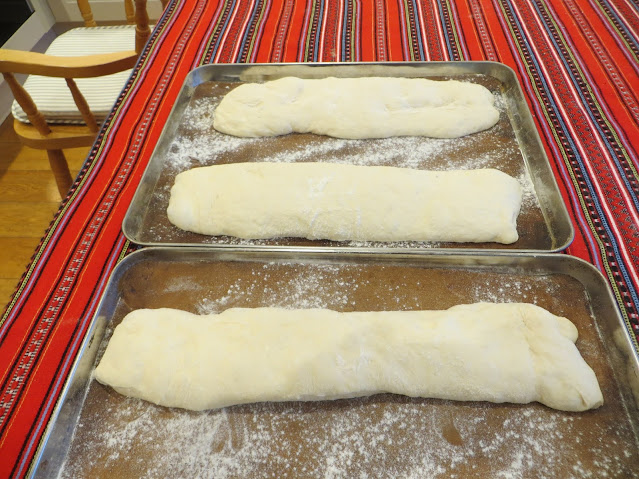Rustic Ciabatta
BreadClub20....the award-winning site for Happy Bakers.
2021 : World Bread Awards : Winner - Wales
Welcome to another step-by-step recipe from BreadClub20. Why not drop by our main Facebook page by clicking here.... If you like what you see and enjoy the recipe, we hope you go on to join us by 'Liking' and 'Subscribing'.
Meet Arnoldo Cavallari, the man who invented the Ciabatta.
 |
| Arnoldo Cavallari |
And the rest, as they say, is history....
As many of you will know, the provenance of bread is important to me. True, you can make ciabatta with sourdough, or in a one day bake, or even using French flour.
But, an authentic ciabatta should be made with a biga and preferably from a Tipo 00 flour.
Remember, a poolish and a biga are usually identified by their degree of consistency. A poolish has a higher hydration than a biga and, therefore, is likely to be more loose in its consistency.
A word about the ingredients:
Tipo 00 flour - OK, it's not a dealbreaker. If you can't source Tipo 00, then use Tipo 0 or French T55 flour
Salt - I'm adding smoked salt for flavour. Otherwise, just use sea salt.
Water : filter your water....it makes a difference.
Yeast - I'm using active instant yeast. If you wish to use fresh or dried, remember you'll need to look at a conversion table. There's one below.....
INGREDIENTS
For the biga :
200 gms Tipo 00 flour (12.1% protein)
150 gms tepid filtered water
¼ teaspoon instant yeast
For the dough :
350 gms Tipo 00 flour (12.1% protein)
240 gms tepid filtered water
2 teaspoon smoked sea salt (crushed)
½ teaspoon instant yeast
METHOD
The night before....make the biga
1. Combine 200 gms of flour with 150 gms of water and ¼ teaspoon of instant yeast.
2. Cover and allow it to ferment overnight at room temperature for 12 - 16 hours.
The next day
NB. : This is a very wet and sticky mix. You'll find life a lot easier if you use a stand mixer or a bread machine with an instant start setting and leave the lid up.
If neither of these are options for you, be prepared to work a very sticky dough with the handle of a wooden spoon and keep your hands wet.
1. Mix the biga with the flour, water and yeast in a bowl. Mix at a low speed for two minutes and then continue to mix until the dough forms a mass and starts to pull away from the sides of the bowl. Resist the temptation to add further flour. If it's absolutely necessary - add very small quantities at a time and allow time for it to work.
By stand mixer : total time probably 18 minutes
By bread machine : total time probably about 15 minutes
By hand : total time probably 20 minutes.
2. Oil a large bowl and with a wet scraper and wet hands, transfer the dough into the oiled bowl. Cover and leave to rest at 20⁰C for one hour.
3. After one hour, perform three sets of stretch and fold at 45 minute intervals. Make sure you stretch and fold each side (north, east, south and west) each time. Cover in between repeats and leave at room temperature.
4. Very generously flour your work surface. Don't be mean with the flour. Also, if you can use coarse flour (rice or semolina), so much the better.
5. Be gentle from here on in.
6. Slide the dough out onto the floured worktop. Flour the top of the dough. Using your scraper, try and form the dough into a square or rectangle.
7. Using a metal scraper, divide the dough into suitable portions. Remember a ciabatta should be slipped-shaped, so do your next to cut them in a similar form...long rectangular and thin.
8. Carefully, slide and transfer the dough onto a sheet of parchment paper. Reflour the tops of the dough
9. Cover with a sheet of parchment paper or a floured tea towel and leave at room temperature (or slightly higher) for about 30 minutes, until the surface grows small bubbles.
10 Preheat your oven to 230⁰C - if you're baking on a baking stone or metal sheet, don't forget to preheat these as well. If you're adding water for extra steam, place a small bowl on the bottom of the oven.
11. When you're ready, add some boiling water to your small bowl in the oven and mist the inside of the oven. Mist the dough. Carefully slide the parchment paper onto the stone and mist the dough once again.
12. Bake for 25 minutes without opening the oven door. You're looking for a deep golden brown colour and an internal temperature of 99⁰C.
13. Transfer to a rack to cool.
When you're ready to serve, you can re-heat the ciabatta by wrapping them in foil and placing them in an oven at 180⁰C for five or ten minutes.
Happy baking....









Comments
Post a Comment